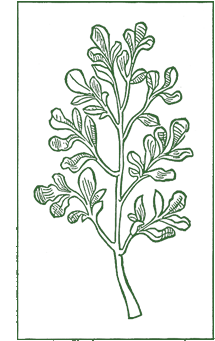Of disagreeable odor and acrid taste, this woody medicinal herb was used as a stimulant and antispasmodic in the Middle Ages, as well as in food as proof against poison. It was also strewn about law courts in parts of Great Britain to ward off disease carried by criminals. From its bitterness, it came to symbolize repentance; and when used mixed with holy water it was called herb of grace.
 “Here did she fall a tear; here, in this place,
“Here did she fall a tear; here, in this place,
I’ll set a bank of rue, sour herb of grace:
Rue, even for ruth, here shortly shall be seen,
In the remembrance of a weeping queen.”
—Richard II (III, iv, 102–7)
Ophelia is playing on the meanings of the two words associated with the name of the plant: rue for repentance and ruth for pity. The former signification is for the queen, the latter is for herself. The word difference alludes to the rules of heraldry, where the younger brothers of a family bear the same arms, but with some mark of distinction.